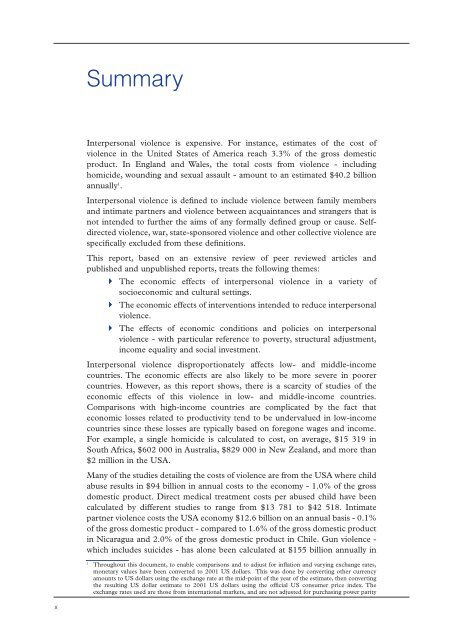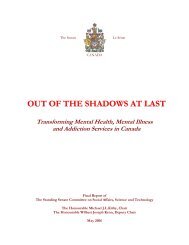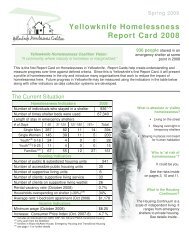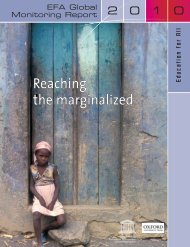The economic dimensions of interpersonal violence - libdoc.who.int ...
The economic dimensions of interpersonal violence - libdoc.who.int ...
The economic dimensions of interpersonal violence - libdoc.who.int ...
- No tags were found...
Create successful ePaper yourself
Turn your PDF publications into a flip-book with our unique Google optimized e-Paper software.
SummaryInterpersonal <strong>violence</strong> is expensive. For instance, estimates <strong>of</strong> the cost <strong>of</strong><strong>violence</strong> in the United States <strong>of</strong> America reach 3.3% <strong>of</strong> the gross domesticproduct. In England and Wales, the total costs from <strong>violence</strong> - includinghomicide, wounding and sexual assault - amount to an estimated $40.2 billionannually 1 .Interpersonal <strong>violence</strong> is defined to include <strong>violence</strong> between family membersand <strong>int</strong>imate partners and <strong>violence</strong> between acqua<strong>int</strong>ances and strangers that isnot <strong>int</strong>ended to further the aims <strong>of</strong> any formally defined group or cause. Selfdirected<strong>violence</strong>, war, state-sponsored <strong>violence</strong> and other collective <strong>violence</strong> arespecifically excluded from these definitions.This report, based on an extensive review <strong>of</strong> peer reviewed articles andpublished and unpublished reports, treats the following themes:<strong>The</strong> <strong>economic</strong> effects <strong>of</strong> <strong><strong>int</strong>erpersonal</strong> <strong>violence</strong> in a variety <strong>of</strong>socio<strong>economic</strong> and cultural settings.<strong>The</strong> <strong>economic</strong> effects <strong>of</strong> <strong>int</strong>erventions <strong>int</strong>ended to reduce <strong><strong>int</strong>erpersonal</strong><strong>violence</strong>.<strong>The</strong> effects <strong>of</strong> <strong>economic</strong> conditions and policies on <strong><strong>int</strong>erpersonal</strong><strong>violence</strong> - with particular reference to poverty, structural adjustment,income equality and social investment.Interpersonal <strong>violence</strong> disproportionately affects low- and middle-incomecountries. <strong>The</strong> <strong>economic</strong> effects are also likely to be more severe in poorercountries. However, as this report shows, there is a scarcity <strong>of</strong> studies <strong>of</strong> the<strong>economic</strong> effects <strong>of</strong> this <strong>violence</strong> in low- and middle-income countries.Comparisons with high-income countries are complicated by the fact that<strong>economic</strong> losses related to productivity tend to be undervalued in low-incomecountries since these losses are typically based on foregone wages and income.For example, a single homicide is calculated to cost, on average, $15 319 inSouth Africa, $602 000 in Australia, $829 000 in New Zealand, and more than$2 million in the USA.Many <strong>of</strong> the studies detailing the costs <strong>of</strong> <strong>violence</strong> are from the USA where childabuse results in $94 billion in annual costs to the economy - 1.0% <strong>of</strong> the grossdomestic product. Direct medical treatment costs per abused child have beencalculated by different studies to range from $13 781 to $42 518. Intimatepartner <strong>violence</strong> costs the USA economy $12.6 billion on an annual basis - 0.1%<strong>of</strong> the gross domestic product - compared to 1.6% <strong>of</strong> the gross domestic productin Nicaragua and 2.0% <strong>of</strong> the gross domestic product in Chile. Gun <strong>violence</strong> -which includes suicides - has alone been calculated at $155 billion annually in1Throughout this document, to enable comparisons and to adjust for inflation and varying exchange rates,monetary values have been converted to 2001 US dollars. This was done by converting other currencyamounts to US dollars using the exchange rate at the mid-po<strong>int</strong> <strong>of</strong> the year <strong>of</strong> the estimate, then convertingthe resulting US dollar estimate to 2001 US dollars using the <strong>of</strong>ficial US consumer price index. <strong>The</strong>exchange rates used are those from <strong>int</strong>ernational markets, and are not adjusted for purchasing power parityx
















